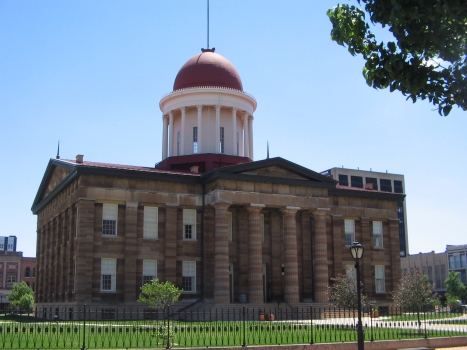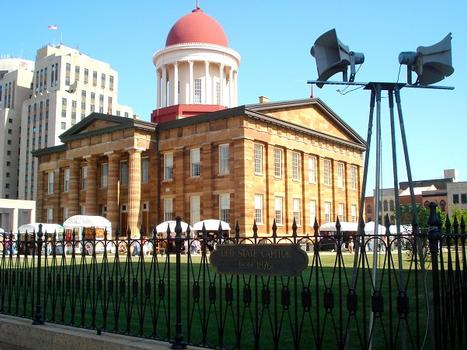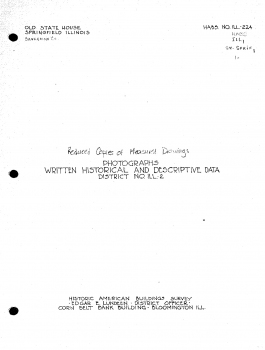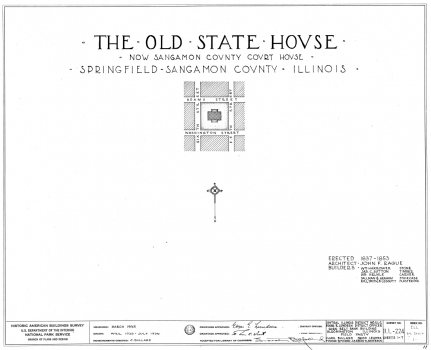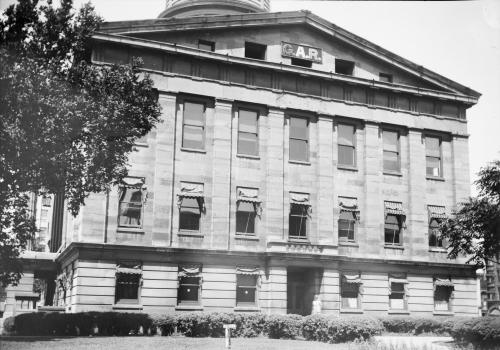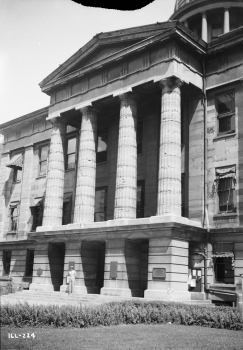General Information
| Other name(s): | Sangamon County Courthouse; Third State Capitol |
|---|---|
| Beginning of works: | 1837 |
| Completion: | 1853 |
| Status: | in use |
Project Type
| Structure: |
Dome |
|---|---|
| Function / usage: |
Parliament building |
| Architectural style: |
Greek Revival |
| Function / usage: |
Court house |
| Material: |
Structurae Plus/Pro - Subscribe Now! dome: Steel structure building: Masonry structure |
Awards and Distinctions
| 1966 |
for registered users |
|---|---|
| 1961 |
for registered users |
Location
| Location: |
Springfield, Sangamon County, Illinois, USA |
|---|---|
| Coordinates: | 39° 48' 4.21" N 89° 38' 55.02" W |
Technical Information
Materials
| piers |
stone
|
|---|---|
| foundations |
brick
|
| dome |
steel
|
| walls |
brick
|
| floor slabs |
concrete
|
| beams |
steel
|
| veneer |
stone
|
Excerpt from Wikipedia
The Old State Capitol State Historic Site, in Springfield, Illinois, is the fifth capitol building built for the U.S. state of Illinois. It was built in the Greek Revival style in 1837–1840, and served as the state house from 1840 to 1876. It is the site of candidacy announcements by Abraham Lincoln in 1858 and Barack Obama in 2007. It was designated a National Historic Landmark in 1961, primarily for its association with Lincoln and his political rival Stephen Douglas.
State House
From 1820 through 1837, the political capital of the young state of Illinois was the small village of Vandalia, Illinois, in the south center of the state. On the National Road, Vandalia was initially well-situated to fulfill its governmental role. As northern Illinois opened to settlement in the 1830s, however, public pressure grew for the capital to be relocated to a location closer to the geographic center of the state.
A caucus of nine Illinois lawmakers, including the young Whig Party lawyer Abraham Lincoln, led the effort to have the capital moved to the Sangamon County village of Springfield. Their efforts were successful in 1837, when the Illinois General Assembly passed a law creating a two-year transition period with the goal of moving the capital to Springfield in 1839.
Workers built a state office building, large for the time, on the central square in Springfield in 1837–40. The cost was $240,000, of which the city of Springfield paid $50,000. The structure, designed by local architect John Francis Rague and constructed of locally quarried yellow Sugar Creek limestone, contained chambers for both houses of the General Assembly, offices for the Governor of Illinois and other executive officials, and a chamber for the Illinois Supreme Court.
It was in this building that Lincoln served his final term as a state lawmaker in 1840–41. As a lawyer, he pleaded cases before the state supreme court in this building (1841–60). In the Illinois House chamber, Lincoln made his House Divided speech in June 1858, announcing his candidacy for the U.S. Senate. It was to the same chamber, in May 1865, that his body was returned to lay in state, arriving from Washington, D.C., prior to final burial in Springfield's Oak Ridge Cemetery.
As a result of economic growth spurred by the American Civil War and consequent industrialization, this fifth or Old State Capitol was, by the 1870s, too small to serve the purpose for which it had been built. Illinois built its sixth and current State Capitol building four blocks to the southwest, and the state government turned the Old State Capitol over to Sangamon County to serve as the county courthouse.
Courthouse
From 1876 until 1966, the Old State Capitol was the county courthouse of Sangamon County. During this time the building was extensively altered. In 1839, a two-floor building had been large enough to hold the entire governmental structure of Illinois; but after continued growth in the population of Springfield and the surrounding townships, in 1898-1899 Sangamon County raised the historic structure 11 feet (3 meters), added a third floor under it, and demolished and reconfigured the interior to hold circuit court rooms and office space.
In the early 1960s, the Civil War centennial rekindled interest in the historic central Springfield structure. In addition, Sangamon County's space needs had grown so urgent as to require the county to build for itself an entirely new courthouse building. The county retroceded the Old State Capitol to the state of Illinois, this time as a place of public assembly and museum of Lincoln history.
Illinois Historic Preservation Agency
In order to restore and preserve the Old State Capitol, which had been extensively altered during its life as a courthouse, workers completely dismantled it, stone by stone, and rebuilt it. The public areas of the Old State Capitol were reconstructed to resemble the appearance of the building in 1860, when Lincoln last saw the capitol prior to his departure to Washington.
The state also excavated the plaza under and around the Old State Capitol to construct an extensive office and parking complex, which later served as the headquarters of the Illinois Historic Preservation Agency.
The reconstruction work was carried out in 1966–69, and the rebuilt House Chamber was available for the state's Constitutional Convention to use in 1970.
The restored Old State Capitol continues to be used for ceremonial functions. In February 2007 then-U.S. Senator Barack Obama officially announced his candidacy for President of the United States at this location, and in August 2008 he formally introduced his vice-presidential candidate, Joe Biden, with the building as a backdrop.
Visitors can tour the capitol on their own or take 30-minute guided tours.
Text imported from Wikipedia article "Old State Capitol State Historic Site" and modified on May 24, 2020 according to the CC-BY-SA 4.0 International license.
Participants
- John F. Rague (architect)
Relevant Web Sites
- About this
data sheet - Structure-ID
20040278 - Published on:
03/11/2008 - Last updated on:
24/05/2020

